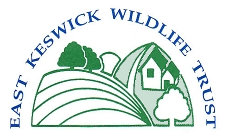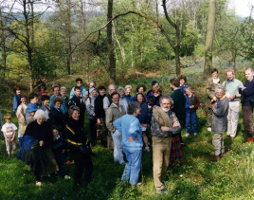East Keswick Wildlife Trust is a village-based charity, founded in the early 1990’s, which owns and manages considerable tracts of lands within the parish boundary. Since their childhood, East Keswick residents had observed many changes in the local environment including the loss of woodland and flower-rich pastures, the draining of wildlife-rich wet meadows and the removal of hedgerows. EKWT was set up with the aim of safeguarding the remaining wildlife and natural habitats in the parish by acquiring and managing sites of local, regional and national importance and by encouraging landowners to include conservation as a criterion in land management.
One of the first campaigns was to purchase Ox Close Wood, a thirty-five acre woodland close to the River Wharfe. Ox Close wood has many plants indicative of ancient woodland and is one of the most important deciduous woodlands in the region. Lying partly on the edge of the magnesium limestone belt and containing both acid and alkaline soils and the associated flora suited to either, it is rich in species. The 1992 asking price of £25,000 was feared to be beyond reach. However, in May 1992, interested local people were invited to walk the paths through the wood. The beauty of the area captivated those who took part; one local supporter offered to back the Trust with a large donation towards the purchase price. When the Trust used its charitable status to claim the tax back through Gift Aid the purchase became a realistic goal. Other donations followed from local residents and ‘Leeds Birdwatchers’, ‘Leeds Urban Wildlife Group’, ‘Leeds Naturalists and Scientific Association’, and ‘Esmee Fairburn Charitable Trust’ making it possible that by March 1993 the Trust was the owner of the largest woodland in the parish.
By this time the Trust had identified Keswick Marsh, a six-acre area of wet pasture, as an area of interest. It was a type of habitat becoming increasingly uncommon as almost all wet pasture in surrounding countryside was drained , treated with herbicides and re-seeded to increase agricultural productivity. The Trust approached the Parish Council with the offer to manage the area and the request for a small grant towards its care. This was accepted and three ponds were dug to increase the area of permanent water. The area became Keswick Marsh Nature Reserve and display boards were erected to inform visitors what flora and fauna to look out for. It is now one of the few examples left locally of a semi-natural wet pasture with accompanying rich flora and fauna.
The third piece of land that the Trust took responsibility for was a small redundant limestone quarry and associated field. Known as Frank Shire’s quarry, the land was in the ownership of the Parish Council and, as with Keswick Marsh, the Trust agreed terms with the council for its management. The meadow is one of the few uncultivated pastures left in the parish.
Within eighteen months of its launch the Trust had sixty local families and individuals in its membership and secured a modest annual grant from the Parish Council. Since then membership has doubled, thanks, in part, to an imaginative programme of events organised by the Trust involving all ages in the local community. Mini beast mornings in the Village Hall, pond dipping at Keswick Marsh, evening discussions and lectures, dormouse and river surveys, bird and bat box making days, tree identification days, fungi hunts, orienteering, treasure hunts, animal tracks and signs recognition, dawn chorus walks and other national initiatives, such as cultivating the once common Black Poplar and tree and hedgerow surveys, are just some of the fun and educational ways the Trust entices villagers to care for their wildlife heritage, whilst at the same time providing socialising opportunities and so helping to preserve the parish community atmosphere. Local schools have carried out surveys on Trust land, Brownies have worked towards conservation badges there, evening campfires have been held in Ox Close Wood by cubs, whilst Rainbows and Beavers have learned how to make string from nettles and soap from horse chestnut leaves there and teenagers have worked towards their Duke of Edinburgh Awards with the Trust. In conjuction with the British Trust for Conservation Volunteers, young and old Trust volunteers alike have given thousands of hours to adding or repairing gates and stiles, cutting steps, erecting fencing and planting hedging. And all villagers can buy the charcoal the Trust has produced from trees felled in the wood for effective conservation management.
East Keswick Wildlife Trust has provided a stimulus to the care of the environment felt far beyond the forty plus acres of rich wildlife it presides over. It has become a unique and highly prized asset of a distinctive community.
Since these early years, the Trust has acquired additional areas of land to develop into reserves. In 2003/4 two purchases were made. Elliker Field (0.72ha, 1.8ac) was purchased mainly through donations from the community and Elliker Wood (1.1ha, 2.75ac) was purchased with the aid of a grant. These two areas are just to the east of The Paddock in East Keswick. Elliker Field is a south facing meadow the upper half of which is lying over Magnesian Limestone. Adjoining Elliker Field, Elliker Wood has been managed by creating wide rides to let more light into the wood to attract more plant and animal wildlife. Both these reserves have been fenced and Elliker Field will benefit enormously from conservation grazing during the appropriate time of year.
Friday Workparty
There is a Workparty every Friday when volunteers manage our reserves. There are diverse activities such as clearing and thinning woodland, cutting and raking grass, fencing and preparing the charcoal kilns for our charcoal making events. See the Forthcoming Events window on the home page for event dates.
If you would like to join any of our workparties, please contact info@ekwt.org.uk to find out the location of the next work day.




